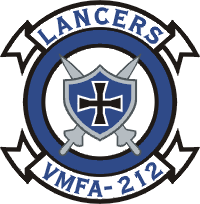
Marine Fighter Attack Squadron 212 (VMFA-212) was a United States Marine Corps F/A-18 Hornet squadron. Most recently known as the "Lancers", the squadron was last based at Marine Corps Air Station Iwakuni, Japan and fell under the command of Marine Aircraft Group 12 (MAG-12) and the 1st Marine Aircraft Wing. Due to a re-organization within Marine aviation, the squadron was deactivated in 2008. It is scheduled to be reactivated as an MV-22B squadron in 2019 under MAG 26 at MCAS New River, NC.

No. 2 Squadron RNZAF was a squadron of the Royal New Zealand Air Force (RNZAF). It was formed in 1930 as part of the Territorial Air Force with the main headquarters at Wellington and shadow flights at New Plymouth and Wanganui. Squadron personnel conducted their annual flying at RNZAF Base Wigram. In 1937 the Territorial Squadrons were re-organised and No. 2 Squadron became the Wellington Territorial Squadron.

14 Squadron RNZAF is a squadron of the Royal New Zealand Air Force. In 2015 the squadron was re-raised and equipped with 11 Beechcraft T-6 Texan II. A new aerobatic display team called the Black Falcons was also formed using the new aircraft. They replaced the RNZAF display team known as the Red Checkers.
No. 16 Squadron Royal New Zealand Air Force was formed on 1 July 1942 at RNZAF Base Woodbourne, commanded by Squadron Leader A. Jones. The squadron served in Espiritu Santo, Guadalcanal, New Georgia, Bougainville, Green Island and Jacquinot Bay. The squadron was equipped with Curtiss P-40 Kittyhawks and later F4U Corsair fighters. Re-equipment with the P-51 Mustang was abandoned at the cessation of hostilities, and the squadron returned to New Zealand and was disbanded in October 1945.

No. 25 Squadron of the Royal New Zealand Air Force was formed at Seagrove, Auckland in July 1943 with Douglas SBD Dauntless dive bombers and served in the Southern Pacific based at the Piva Airstrip on Bougainville, flying missions against Japanese forces on Bougainville and at Rabaul. It was disbanded in May 1944 and reformed as a fighter/ground attack squadron flying F4U Corsairs. It served in Santo, Guadalcanal, Los Negros and Emirau, before returning to New Zealand and being disbanded in September 1945. A SBD-4 Dauntless operated by 25 Squadron was for a time preserved in the Royal New Zealand Air Force Museum at Wigram, displayed in the condition which it was recovered after being lost with its crew while on a training mission at Espiritu Santo. One of the SBD-5 aircraft operated by 25 Squadron has been restored to flying condition in America for the "Planes of Fame" museum, in the colour scheme of an American aircraft.

No. 30 Squadron RNZAF was a New Zealand light bomber squadron which saw service against the Japanese in the Pacific Theatre during the last two years of the Second World War.
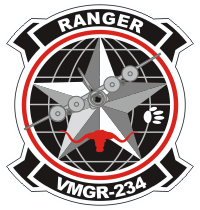
Marine Aerial Refueler Transport Squadron 234 (VMGR-234) is a reserve United States Marine Corps KC-130J squadron. They are a part of Marine Aircraft Group 41 (MAG-41), 4th Marine Aircraft Wing and provide both fixed-wing and rotary-wing aerial refueling capabilities to support Marine Forces Reserve air operations in addition to assault air transport of personnel, equipment, and supplies. The squadron, known as the "Rangers" is stationed at Naval Air Station Joint Reserve Base Fort Worth, Texas.
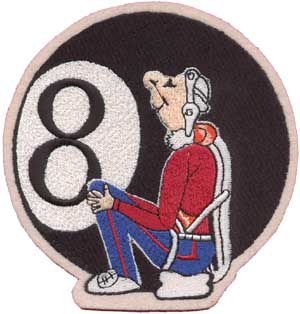
Marine Fighter Squadron 123 (VMF-123) was a fighter squadron of the United States Marine Corps during World War II and in the Marine Forces Reserve. Known as the “Flying Eight Balls,” they fought on Guadalcanal, Iwo Jima, and Okinawa and served as a training squadron for replacement pilots during the Korean War. They were deactivated in the late 1950s and remain in an inactive status today.
No. 9 Squadron RNZAF was a New Zealand bomber reconnaissance squadron in the Pacific Theatre of World War II.
No. 17 Squadron RNZAF was a New Zealand fighter squadron in the Pacific Theatre of World War II.
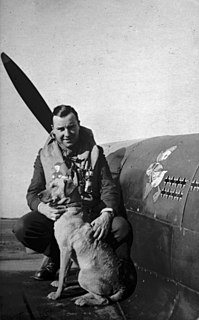
John Albert Axel Gibson, was a Royal Air Force (RAF) officer and a flying ace of the Second World War. He was credited with the destruction of 12 enemy aircraft.

No. 26 Squadron RNZAF was a squadron of the Royal New Zealand Air Force. Formed in October 1943, during World War II, from "C Flight", No. 25 Squadron at RNZAF Station Seagrove to be equipped with Douglas SBD Dauntless dive bombers, however was disbanded in January 1944. Reformed in March 1945 at RNZAF Station Ardmore, equipped with Chance-Vought F4U-1 Corsair fighter bombers. The squadron was based at Kukum Airfield on Guadalcanal and Piva Airfield on Bougainville before being disbanded in June 1945.
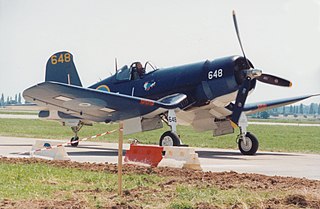
No. 22 Squadron RNZAF was a squadron of the Royal New Zealand Air Force. Formed in August 1942, during World War II, at RNZAF Station Onerahi equipped with the Hawker Hind, co-ordinating with New Zealand Army units providing training for air liaison officers. Reformed on 19 June 1944 at RNZAF Station Ardmore, equipped with Chance-Vought F4U-1 Corsair fighter bombers. The squadron served at airfields in Espiritu Santo, Guadalcanal, Bougainville and Emirau before being disbanded in September 1945.
No. 19 Squadron was a squadron of the Royal New Zealand Air Force. Formed on 10 December 1941 at RNZAF Station Ohakea from members of No. 3 Squadron equipped with P-40 Kittyhawk and later with the Chance-Vought F4U-1 Corsair fighter bombers.
No. 20 Squadron was a squadron of the Royal New Zealand Air Force. Formed in January 1944 at RNZAF Station Ohakea, it was originally equipped with P-40 Kittyhawks. It later flew F4U-1 Corsair fighter bombers.
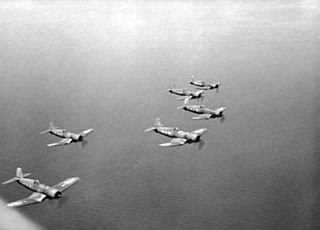
No. 18 Squadron was a squadron of the Royal New Zealand Air Force. Formed in June 1943 at RNZAF Base Woodbourne, the squadron was initially equipped with Curtiss P-40 Kittyhawks, before converting to F4U-1 Corsair fighter bombers in 1944. The squadron fought in the Pacific theatre during World War II, flying combat operations against Japanese forces until it was disbanded in late 1945.
No. 23 Squadron was a squadron of the Royal New Zealand Air Force. It was formed in August 1944 at RNZAF Station Ardmore equipped with the F4U-1 Corsair fighter bomber.
No. 21 Squadron was a squadron of the Royal New Zealand Air Force. Formed in May 1944, it was equipped with F4U-1 Corsair fighter bombers.
No. 24 Squadron was a squadron of the Royal New Zealand Air Force. Formed in September 1944, it was equipped with F4U-1 Corsair fighter bombers.
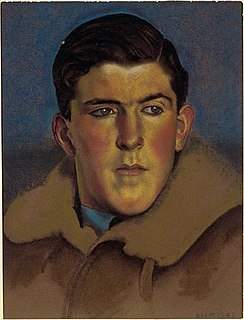
Michael Herrick was a New Zealand flying ace of the Royal Air Force (RAF) during the Second World War. He was credited with the destruction of eight enemy aircraft.










